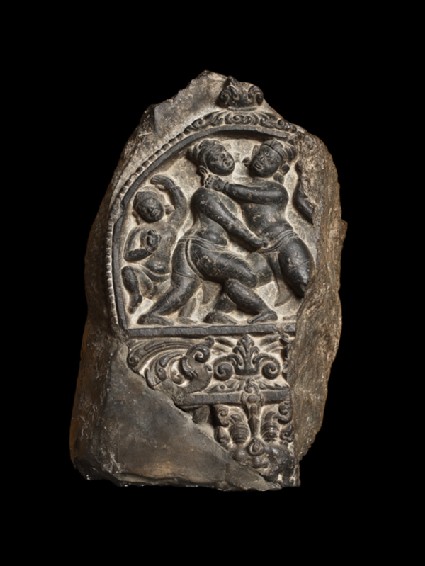Browse: 68 objects
- Reference URL
Actions
Pillar fragment with two wrestlers
-
Details
- Associated place
-
Asia › India › east India › Bihar (place of creation)Asia › India › east India › Bihar › Munger district › Rajaona (possible place of creation)
- Date
- 2nd half of the 7th century - 8th century AD
- Material and technique
- stone; plaster on base
- Dimensions
- 42 x 29 x 35 cm max. (height x width x depth)
- Material index
- Technique index
- Object type index
- No. of items
- 1
- Accession no.
- EAOS.52
-
Further reading
Harle, J. C., and Andrew Topsfield, Indian Art in the Ashmolean Museum (Oxford: Ashmolean Museum, 1987), no. 39 on pp. 29-30, illus. p. 30
Cohn, William, ‘Der Wettkampf im Ringer, ein Relief im Museum of Eastern Art, Oxford’, Schriften des Museums Rietberg, Zurich, 2, (n.d.), illus. pp. 95-71
Location
Objects are sometimes moved to a different location. Our object location data is usually updated on a monthly basis. Contact the Jameel Study Centre if you are planning to visit the museum to see a particular object on display, or would like to arrange an appointment to see an object in our reserve collections.
Galleries
Publications online
-

Indian Art in the Ashmolean Museum
The fluting which can be discerned at the top of this fragment identify it as part of a pillar and not necessarily the base, since, from the 6th century onwards, temple pillars were interrupted with median bands which were often richly decorated. Semi-circular medallions such as this one with a pearl border and bearing relief figures, accompanied by foliage work usually incorporating, a kīrtimukha are, moreover, found on a great many of the pillars which have survived from temples of the post-Gupta period all the way from Bodhgaya to Mahasthan in Bangladesh.
The grotesque mask (kīrtimukha or “face of glory”), part human, part leonine and even with a suggestion of horns, has its remote origin in western classical antiquity [see EAX.66, EAX.67, and EAX.68]. In later times it tends to lose its human features, and the fact that this kirtimukha is still recognisably human argues for a relatively early date for the fragment, in the 8th and possibly even the late 7th century A.D. As for the wrestlers, wrestling has always been popular in the northern part of India and representations on reliefs show a knowledge of the sport. Where other indicators exist, the contestants have been variously identified as those heroes from myth or the epics who engaged in wrestling contests such as Bhīma and Jarasandha, or Kṛṣṇa and Cāṇūra, but here there are not sufficient clues to suggest an identification.
© 2013 University of Oxford - Ashmolean Museum





